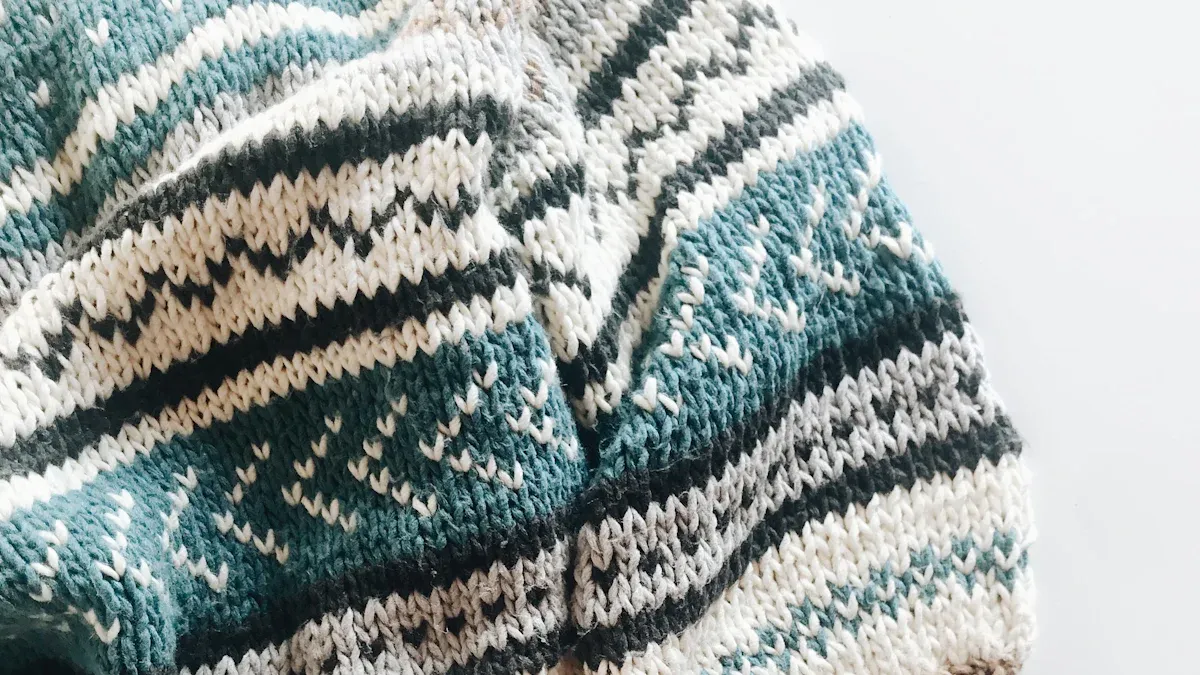
Modern knitting brings together the best of old and new. You see handlooms in Asia work alongside smart machines, while Europe and the Americas blend heritage with digital precision. Check out the table below to see how different regions mix tradition with innovation in this craft:
Aspect | Evidence Supporting Blending Traditional and Innovative Techniques |
|---|---|
Regional Practices | Asia uses handlooms alongside integrated IoT systems and variable twist technology, showing coexistence of traditional and modern methods. Europe combines historic power looms with computer-controlled smart systems. Americas blend adapted European methods with mass production and automation. |
Mathematical Modeling | Design Quality is quantified as a function of Pattern Complexity, Yarn Uniformity, and Production Variability, requiring balance between artisanal design and production efficiency. Parameters like yarn tension, needle arrangement, twist level, and color integration are adjusted using digital controls and variable twist systems. |
Sustainability Metrics | Modern digital/sustainable production reduces energy consumption by 15–25% compared to conventional methods, significantly lowers water usage, and minimizes waste generation, demonstrating benefits of integrating traditional knowledge with innovative processes. |
Workforce Development | Certification programs and training combine traditional knitting skills with digital machine operation, preparing workers to master both heritage techniques and modern technology. |
Hybrid Technologies | Emerging hybrid systems merge handloom artistry with digital precision, enhancing design flexibility, quality control, and cultural preservation, embodying the blend of traditional and innovative approaches. |
You don’t just need needles and yarn anymore. Knitters now use digital resources every day. In fact, 93% go online for patterns and ideas, and 67% connect through social media.
This craft keeps growing. Ravelry, a global online community, has over 6 million members. You find knitters of all ages sharing, learning, and shaping the future of knitting together.
Key Takeaways
Modern knitting blends traditional handcraft with digital tools and machines, making the craft faster, more precise, and creative.
Digital platforms and software help knitters design patterns, fix mistakes, and share ideas worldwide, growing a vibrant online community.
Techniques like seamless construction, circular yokes, cable knitting, and colorwork let you create stylish, comfortable, and unique knitwear.
You can find knitting patterns for all skill levels, from simple scarves to complex sweaters, including updated vintage styles.
Joining knitting groups and using trusted books, apps, and organizations boosts your skills, creativity, and enjoyment of the craft.
Modern Knitting Today
Knitting in the Digital Age
You live in a time when modern knitting feels more exciting than ever. Digital tools and platforms have changed how you approach this craft. You can now use software to design patterns, control knitting machines, and even debug your work like a coder. Here’s how digital platforms shape knitting as a modern craft:
You can blend software programming with traditional knitting, using machines like the SilverReed SK840 and systems such as SReeDuino.
Debugging methods from coding help you spot and fix mistakes in your patterns.
Patterns like Stockinet and Bird’s Eye can show you if your machine or digital system has errors.
You can design patterns that make digital system activity visible in your finished textile.
New challenges, like aligning data and signals, push you to rethink how you create and read patterns.
With these tools, you can turn your ideas into real, wearable designs faster than ever.
Classic Meets Contemporary
Modern knitting brings together the best of old and new. You see classic cable knits and Fair Isle patterns made with new machines and materials. Check out how tradition and innovation mix in today’s designs:
Evidence Type | Details |
|---|---|
Classic Design Revival | Cable knit, Aran, Fair Isle, and Breton stripes get a fresh look with premium yarns and new shapes. |
Technological Advances | 3D knitting, seamless construction, and machines like Stoll’s Autarkic Direct Feeding create unique textures and fits. |
Cosset Clothing | Launched organic cotton and wool knitwear in 2024, blending sustainability with classic style. |
Woolkind (Scotland) | Personalized scarves highlight craftsmanship and custom designs. |
YOKE (Japan) | Uses advanced fiber tech for modern knitwear. |
Loro Piana (Italy) | Focuses on design and marketing teamwork for innovation. |
Market Growth | Knitwear market is booming, driven by sustainability, customization, and technology. |
Personal Style in Knitwear
You can now express your personal style in knitwear like never before. Modern knitting lets you use 3D design tools, modular collections, and virtual fitting to create pieces that fit you perfectly. Designers use seamless machines and zero-waste methods to make custom designs for both women and men. You can draw inspiration from digital sources, mix simple elements, and create patterns that show off your creativity. This new approach helps you and other knitters shape the future of the craft, making it more personal and exciting for everyone.
Knitting Tools & Machines

Hand Tools Overview
When you start knitting, you need the right tools. Needles come in many sizes and materials. Some knitters love metal needles for their smoothness, while others prefer wood or bamboo for a warmer feel. Fine needles, sometimes as thin as 0.7 mm, help you create detailed work, like historical stockings. These tiny tools let you work with delicate yarn and make beautiful, even stitches. Many knitters say that the right needles make all the difference in their projects. You also need scissors, stitch markers, and measuring tapes. These small accessories help you keep your knitting neat and accurate.
Knitting Machines
Knitting machines have changed the way you can create garments and accessories. Today, you find machines that use automation, digital controls, and even artificial intelligence. These machines help you finish projects faster and with more precision. The market now offers machines for every need, from single-jersey to double-jersey and rib machines. You can even find machines that make seamless garments or complex patterns. Many companies focus on making machines that save energy and reduce waste. In North America, electronic knitting machines are growing in popularity because they allow for fast, custom designs. You can use these machines for sportswear, medical textiles, and even car interiors.
Here’s a quick look at how modern knitting machines compare to traditional needles:
Aspect | Modern Knitting Machines | Traditional Needles |
|---|---|---|
Efficiency | Fast, automated, precise | Manual, slower |
Technology | IoT, AI, real-time monitoring | None |
Production Capacity | Mass production, complex patterns | Small-scale, handcrafted |
Adoption Rates | Growing worldwide | Declining in industry |
Challenges | High cost, quick to become outdated | Low cost, but slow |
Benefits | Less labor, better quality, faster results | More control, personal touch |
Project Bags & Organization
Keeping your knitting organized makes every project more enjoyable. You can use project bags to store your needles, yarn, and patterns. Some bags have pockets for small tools, so you never lose your stitch markers or scissors. Try labeling your bags for each project. This way, you always know where to find what you need. Many knitters use clear containers or baskets at home to keep their supplies tidy. Staying organized helps you finish projects faster and keeps your knitting space stress-free.
Tip: Set up a small basket or bag for each project. This keeps your knitting tools and yarn together and ready to go!
Modern Knitting Techniques
Modern knitting gives you more ways to create than ever before. You can use new techniques to make your projects look professional and unique. These essential knitting techniques help you shape, style, and finish your work with confidence. Let’s explore how you can use these methods, whether you knit by hand or with a machine.
Seamless Construction
Seamless construction changes the way you think about making garments. You can knit a sweater or top in one piece, so you do not need to sew parts together. This method saves time and gives your clothes a smooth, comfortable fit. Many knitters love seamless construction because it feels soft against the skin and looks neat.
Recent research shows that seamless technology can turn yarn into three-dimensional, ready-to-wear garments. You can use seamless knitting machines to meet your needs for comfort, style, and performance. These machines let you create complex shapes, like cubes and cones, using advanced computer systems. You can also combine your craft skills with digital tools to design and program seamless knitwear. This approach helps you make creative and precise pieces, even if you are new to digital knitting.
Tip: Try seamless construction for your next sweater. You will enjoy fewer seams and a better fit!
Circular Yokes
Circular yokes give your sweaters a classic look with a modern twist. You knit the yoke in the round, so the stitches form a smooth circle around the neck and shoulders. This technique lets you add patterns, colors, or textures without breaking the flow of your work.
You can use circular yokes for both hand and machine knitting. Many designers use this method to create sweaters that fit well and look stylish. You can play with different stitches to make your yoke stand out. Some knitters add lace, cables, or colorwork to the yoke for extra flair.
Circular yokes work well for all ages.
You can adjust the size easily.
This technique helps you avoid bulky seams at the shoulders.
If you want to try modern styling and shaping, circular yokes are a great place to start.
Cable Knitting
Cable knitting lets you create raised, twisted patterns that look like ropes or braids. You use a special needle to cross stitches over each other. This technique adds depth and texture to your projects. You can use cables for sweaters, hats, scarves, and even socks.
Hand knitters often enjoy the challenge of cable knitting. You can follow charts or written instructions to make simple or complex designs. Machine knitters can also create cables, though the process may need extra steps or special settings.
Here is a quick guide to cable knitting:
Step | What You Do |
|---|---|
1 | Knit to the cable section |
2 | Slip stitches to cable needle |
3 | Hold in front or back |
4 | Knit next stitches |
5 | Knit stitches from cable needle |
You can mix cables with other stitches for a unique look. Try adding cables to your next project for a classic touch.
Colorwork for Hand and Machine Knitters
Colorwork brings your knitting to life. You use two or more colors in the same row to make patterns, pictures, or stripes. This technique works for both hand and machine knitters. You can try simple stripes or complex designs like Fair Isle or intarsia.
Workshops and expert studies show that modern knitting techniques help you make practical and beautiful items. For example, you can add pockets, holes, or straps to your colorwork projects. Some knitters make sensory-friendly scarves or mittens with pockets for heating pads. These ideas show how you can use colorwork for hand and machine knitters to meet real needs.
Note: Keep your yarns untangled by holding one color in each hand or using yarn guides.
Here are some popular colorwork techniques:
Stranded colorwork: Carry two yarns across the row.
Intarsia: Use blocks of color for pictures or shapes.
Mosaic: Slip stitches to create patterns with only one color per row.
You can use colorwork to show off your style and make your projects stand out. Try mixing colors and stitches to create something new and exciting.
Modern knitting techniques give you endless ways to express yourself. You can blend essential knitting techniques, like seamless construction, cables, and colorwork, to make garments that fit your life and taste. Whether you knit by hand or use a machine, these knitting techniques help you create with skill and confidence.
Modern Knitting Patterns
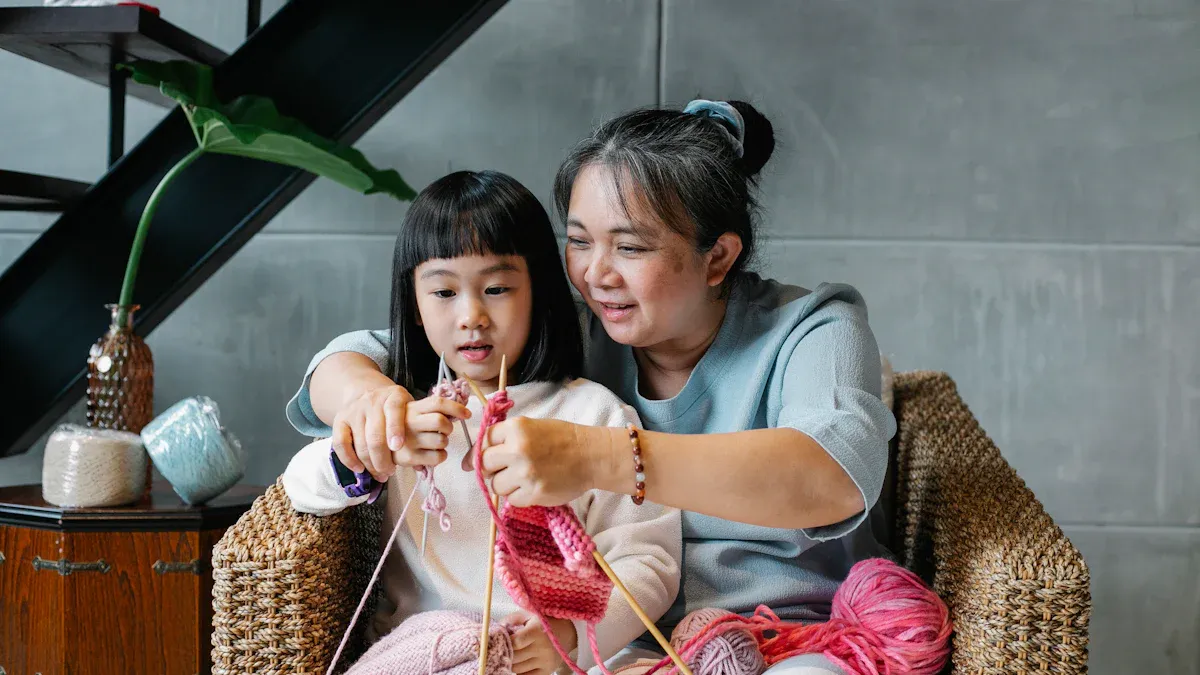
Modern knitting patterns give you endless ways to create. You can find designs for every skill level, from simple scarves to advanced sweaters. Today, you see patterns that mix fashion trends, comfort, and personal style. Many knitters love how these patterns let them show off their creativity and make something unique.
Timeless Sweaters
Sweaters never go out of style. You can knit classic pullovers, cozy turtlenecks, or trendy cropped sweaters. Modern knitting patterns for sweaters often use seamless construction, bold colorwork, or textured stitches. You might see Scandinavian-inspired designs with clean lines and simple shapes. These patterns work well for both women and men.
If you are just starting, try a basic sweater with large needles and chunky yarn. The instructions guide you step by step, so you can finish your first garment with confidence. Intermediate knitters can explore cable knits, lace yokes, or color-blocked designs. Advanced knitters often enjoy sweaters with intricate shaping, multi-strand colorwork, or unusual stitch patterns.
Here are some popular sweater styles you can try:
Raglan sweaters with easy shaping
Circular yoke sweaters with colorful patterns
Oversized pullovers for a relaxed fit
Tip: Choose a pattern that matches your skill level. You will enjoy the process and learn new techniques along the way.
Socks & Accessories
Socks and accessories make great knitting projects for men and women. You can finish them quickly and try out new stitches or colorwork. Modern knitting patterns for socks often use fun stripes, textured stitches, or even cables. Many patterns include detailed instructions for different sizes, so you can make socks for everyone in your family.
Accessories like hats, scarves, and mittens let you experiment with new designs. You can knit a chunky hat with bold cables or a lightweight scarf with lace stitches. Some patterns use mosaic or intarsia colorwork for a modern look. Cardigans and shawls also make great accessory projects, especially if you want to practice new techniques.
Here is a table of popular accessories and the techniques you can try:
Accessory | Techniques to Explore | Skill Level |
|---|---|---|
Socks | Ribbing, cables, stripes | Beginner–Advanced |
Hats | Colorwork, cables, lace | Beginner–Advanced |
Scarves | Garter, lace, mosaic | Beginner–Advanced |
Mittens | Fair Isle, textured stitches | Intermediate–Advanced |
Shawls | Lace, short rows, color blocks | Intermediate–Advanced |
You can find patterns for every taste, from simple to bold. Try mixing colors or adding special stitches to make your accessories stand out.
Adapting Vintage Styles
Vintage styles inspire many modern knitting patterns. You can take a classic design and give it a fresh twist. Many knitters love to update old patterns with new yarns, colors, or shapes. This approach lets you blend tradition with your own style.
You might see cardigans with retro buttons, sweaters with 1970s stripes, or lace shawls with a modern edge. Scandinavian patterns often use minimalist shapes and functional details. These designs work well for both women and men, and you can adjust them to fit your needs.
Social media and online communities make it easy to share your projects and find inspiration. You can join groups that focus on adapting vintage patterns or follow designers who specialize in contemporary sweaters and cardigans. Many websites offer free and paid patterns, so you always have something new to try.
Note: When you adapt a vintage pattern, check your gauge and measurements. Modern yarns may behave differently than older ones.
Here are some resources to help you find and adapt patterns:
Ravelry: Search for modern knitting patterns for men, women, and children.
Knitty: Free patterns and articles on new techniques.
Instagram and Pinterest: Follow designers and see real-life projects.
Books like “Japanese Knitting Stitch Bible” or “The Vintage Shetland Project” for unique stitches and historical designs.
Modern knitting patterns let you create garments and accessories that fit your life. You can choose from simple or complex designs, try new stitches, and make pieces for both men and women. Whether you want to knit a classic sweater, a pair of socks, or a bold cardigan, you will find patterns that inspire you and help you grow as a knitter.
Resources & Community
Books & Apps
You can find a world of inspiration in books and apps. Many knitters love to collect new knitting books. These books offer step-by-step guides, creative ideas, and beautiful photos. You might enjoy titles like “Japanese Knitting Stitch Bible” or “52 Weeks of Socks.” New knitting books come out every year, so you always have something fresh to try. Some books focus on classic patterns, while others teach you modern techniques. You can often download knitting patterns for free from publisher websites or app stores. Many apps let you track your progress, organize your yarn stash, and even scan barcodes to find matching patterns. Try using a free app to keep your craft projects organized and discover new books. If you want to learn more, check out library apps that let you borrow books for free.
Book/App Name | What You Get | Cost |
|---|---|---|
Ravelry App | Pattern library, tracking | Free |
Libby | Borrow books from library | Free |
KnitCompanion | Pattern reader, notes | Free/Paid |
Sirdar Digital Patterns | Hundreds of patterns | Free/Paid |
New knitting books (various) | Latest techniques, ideas | Varies |
Online Communities
You can join online communities to connect with knitters around the world. These groups help you share tips, ask questions, and show off your finished craft projects. Many sites offer free forums and pattern swaps. Ravelry has millions of members who post photos, give advice, and review books. Wool and the Gang’s community saw a huge jump in repeat visits because people love sharing their own craft stories and free patterns. When you join, you see lots of user-generated content, like photos and reviews, which help you pick your next project. Here are some ways these communities help you:
You get active users who post daily.
You see lots of comments, likes, and shares on patterns.
You find free downloads and tutorials.
You meet people who inspire you to try new craft ideas.
You can join groups for every interest, from socks to sweaters.
Many knitters say these communities help them feel less stressed and more creative. Studies show that joining a knitting group can boost your mood, help you focus, and even improve your health.
Trusted Organizations
Trusted organizations support your craft journey. The Craft Yarn Council offers free resources, official tutorials, and guides for all skill levels. You can find free patterns, safety tips, and even health advice for knitters. Groups like the Knitting Guild Association and Sirdar provide expert support and host events. Sirdar’s team creates hundreds of new digital patterns each year, so you always have something new to try. These organizations also run surveys and research to make sure you get the best books and craft tools. If you want to learn from the best, check out their free online classes and pattern libraries.
Tip: Always look for official tutorials and free resources from trusted organizations. They help you learn faster and avoid mistakes.
You have seen how modern knitting brings together old traditions and new ideas. Try out a new tool or technique. You might find a favorite pattern or style. Want to keep growing?
Join a knitting group online or in your town
Start a project that excites you
Explore both classic and modern patterns
Remember, every stitch you make adds to your story as a knitter. Enjoy the journey!
FAQ
What tools do I need to start modern knitting?
You need knitting needles, yarn, scissors, and stitch markers. A project bag helps keep things tidy. If you want to try machine knitting, look for a beginner-friendly model. You can always add more tools as you learn.
How can I fix a mistake in my knitting?
Don’t worry! You can use a crochet hook to pick up dropped stitches. For bigger mistakes, you might “frog” (unravel) your work. Many apps and videos show you how to fix common errors step by step.
Where can I find easy patterns for beginners?
You can find beginner patterns on Ravelry, Knitty, and many free apps. Look for patterns labeled “easy” or “beginner.” Books like “First Time Knitting” also help you get started with simple projects.
Can I use vintage patterns with modern yarns?
Yes! You can use modern yarns for vintage patterns. Just check your gauge before you start. Sometimes, you may need to adjust needle size or yarn weight. This helps your project fit and look right.



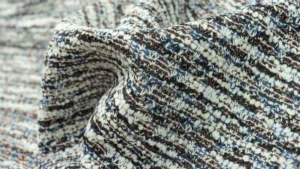
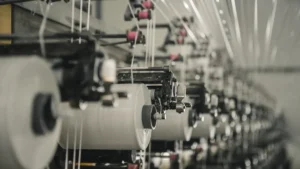
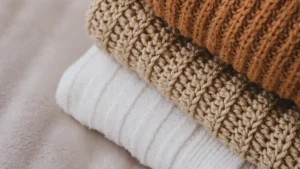


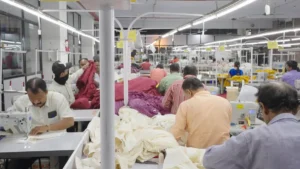

26 thoughts on “Mastering Modern Knitting: Tools, Techniques & Timeless Knitwear”
Pingback: Mastering Knitting Essentials: From Casting On to Choosing the Right Yarn and Needles
Pingback: Dressed in Knits: How Professional Knitwear Factories Build the Perfect Knit Dress
Pingback: From Runway to Production: How Knit Dress Factories Deliver Style, Quality, and Scale
Pingback: Expanding the Knitwear Spectrum: How We Engineer Every Kind of Knitted Dress to Match Global Market Trends
Pingback: Knitwear That Performs: How We Design and Produce Function-First Knitted Dresses for Global Brands
Pingback: Seasonal Style, Technical Precision: Crafting Every Knitted Dress – from Easy Autumn Staples to Statement Cable Sweater Silhouettes
Pingback: A Factory-Level Guide to Producing High-Quality Knitted Dresses and Knit Maxi Dresses
Pingback: top knitwear manufacturer in germany
Pingback: Top Knitwear Manufacturer in France
Pingback: Top Swiss Knitwear Manufacturers to Watch This Year
Pingback: The Best Norwegian Knitwear Manufacturers for Quality and Style
Pingback: Best Knitwear Manufacturing Companies in Sweden This Year
Pingback: Slovenia’s Best Knitwear Manufacturers for Quality and Innovation
Pingback: Top 10 Knitwear Manufacturers in Estonia for 2025
Pingback: San Francisco’s Top Custom Knitwear Brands
Pingback: Top Knitwear Factories in St. Louis for 2025
Pingback: Top-Rated Knitting Manufacturers in Buffalo for Your Next Project
Pingback: 10 Best Knitting Manufacturers in London for Small Businesses
Pingback: Top 10 Knitting Manufacturers in Vienna for 2025
Pingback: Top Manufacturer Makes Zurich Knitwear Shine Bright
Pingback: Best Options for Custom Knitwear Production in Athens
Pingback: Helsinki’s Most Trusted Knit Garment Suppliers
Pingback: Best-Rated Knit Apparel Manufacturers in Tallinn This Year
Pingback: Knit Cotton Fabric: Uses, Construction, and B2B Applications
Pingback: Knit Cuff vs Gusset Cuff Tips for Better Sleeve Finishes
Pingback: How to find the true Ralph Lauren cable knit pullover manufacturer without stress